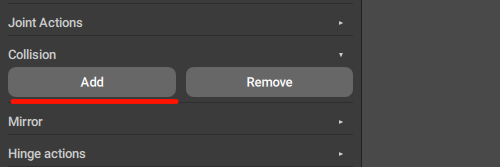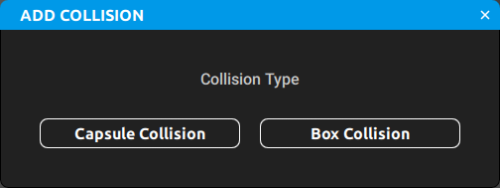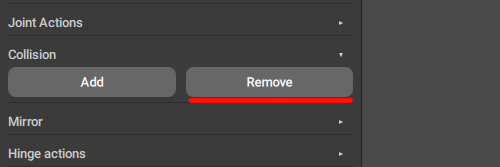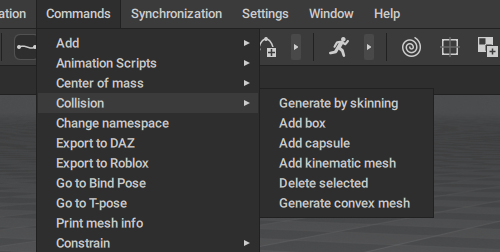Collision Shapes
- Home
- Rig
- Rig Structure
- Rig Elements
- Collision Shapes

Collision Shapes (or Colliders) are objects that are used for calculating a character’s interaction with other objects in the scene.
This part of the rig is used by the following tools:
By default, Collision Shapes are only visible in the Rig Mode and in Rigging View mode.
However, you can make them visible by enabling Colliders in the Visible menu:

Working with Collision Shapes in Rig Mode
Collision Shapes can be added while you’re in the Rig Mode.
At least one collision shape is added automatically to Rigid Bodies, both when they’re created using Quick Rigging Tool and manually.
Creating Colliders
To manually create a collider in Rig mode:
1. Select a Rigid body in the Viewport.
2. Click the Add button in the Collisions section:

3. Then, select a type for the collider:

There are two default options available for Rigid bodies: a capsule-shaped (Capsule Collision) and a cuboid-shaped (Box Collision) object.
After this, a new Collision Shape will be created and attached to the Rigid Body you selected.
Newly created Collision Shape’s dimensions are matching the size of the Rigid Body; you can first change the Rigid Body’s size by adjusting the 'Ellipsoid' vector value to fit your character mesh and then remove and add a new Rigid Body.
This operation should be done for every part of the rig that needs a collision object. Otherwise, the body part without a collider will be passing through the floor and other colliders.
Removing Colliders
To manually remove a collider in Rig mode:
1. Select a collider object in the Viewport.
2. Click the Remove button in the Collision section:

After this, the selected Collision Shape will be removed.
Adjusting Colliders
In certain cases, collision shapes in your character’s rig might need some manual adjustments, to better fit your character’s mesh.
Selected Collision Shapes can be moved and rotated in the Viewport with a Manipulator, just like other regular Transform objects.
The Scale manipulator does not work for Collision Shapes, but you can change their dimensions in the dedicated group of settings: Box collision or Capsule collision, depending on the type of the Shape:

Both contain parameters for adjusting the dimensions of the corresponding shapes.
This can be useful when you want Collision Shapes to better match the surface of the character model.
For the same reason, you can add more than one Collision Shape to a rig element.
Some of the default Cascadeur rigs use this, especially for the characters’ feet:

Working with Collision Shapes in Animation Mode
Colliders can also be managed in the Animation Mode, using a set of options in the Commands menu:

Note
This section will talk about the Collision Shapes in the character rig. If you want to learn how to apply colliders to environment objects, see the Interaction with Environment page.
Creating Colliders
(TODO)
Removing Colliders
(TODO)
Adjusting Colliders
(TODO)
Intersections
When you create Collision Shapes for your rig, you can end up with shapes that intersect with each other:

These intersections can be ignored when it is parent and child colliders that intersect. For example, when an arm collider intersects with a collider for the clavicle, there won’t be any negative effect.
But in other cases - like with the neck and a clavicle on the picture above - such intersections might lead to issues.
If you only plan to use the Interaction with Environment feature, this can be ignored.
But if you enable Ragdoll, you’ll need to adjust the setting so the intersecting shapes would ignore each other.
If you are using the Quick Rigging Tool, this is done automatically.
In other cases, however, you’ll have to set things manually.
Note
This should be done in the animation mode (i.e. after the rig is completed).
To do this:
1. Select the shapes.
2. Go to the Node Editor:

3. You’ll see nodes that represent the Collision Shapes you’ve selected.
4. Select one of these nodes.
5. Open the panel at the left.
6. Find the Collision Material group of settings:

If there is no such group, add it by clicking the plus icon and searching for Collision Material:

7. Now, lock the panel by clicking the lock icon.
This way, it won’t disappear when you deselect the node.
8. Select the node that represents the shape you want to set as ignored.
9. Hold Ctrl and left-click the ignored_objects field.
10. The shape you’d selected should be added to the ignored list:

Now, this Collision Shape won’t register intersections with the shape you’ve added to the field.
Repeat these steps for each shape you want to set as ignored - and for each shape you want to ignore some other shapes.